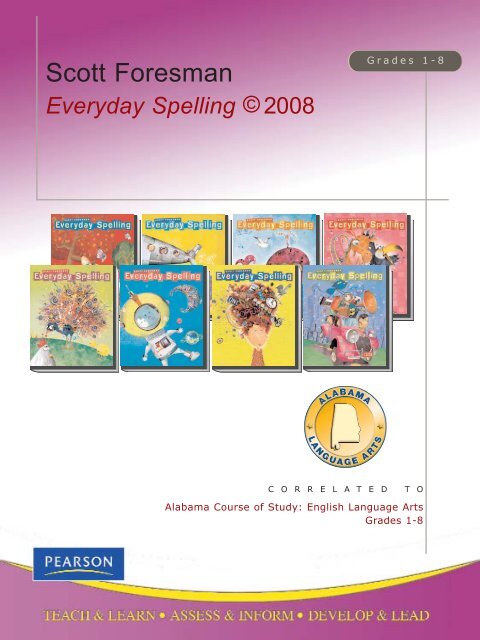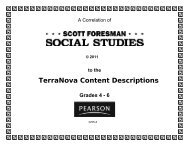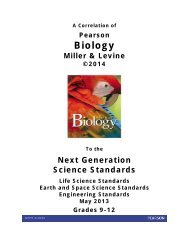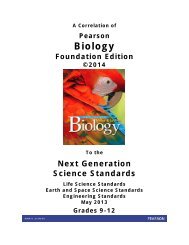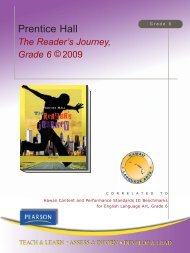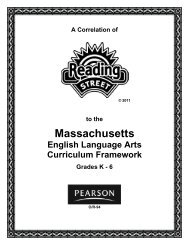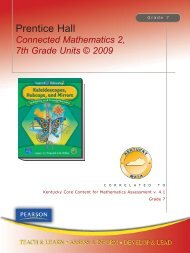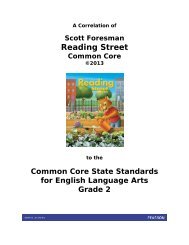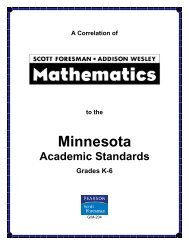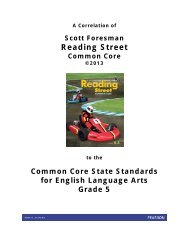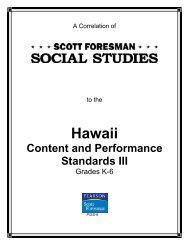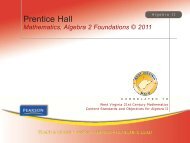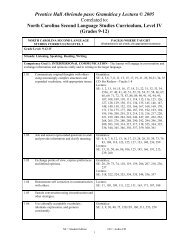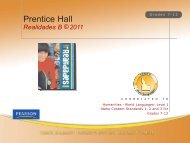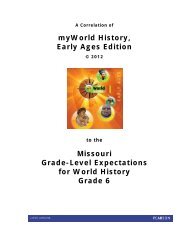Scott Foresman Spelling - Pearson
Scott Foresman Spelling - Pearson
Scott Foresman Spelling - Pearson
Create successful ePaper yourself
Turn your PDF publications into a flip-book with our unique Google optimized e-Paper software.
<strong>Scott</strong> <strong>Foresman</strong><br />
Everyday <strong>Spelling</strong> © 2008<br />
Grades 1-8<br />
C O R R E L A T E D T O<br />
Alabama Course of Study: English Language Arts<br />
Grades 1-8
Introduction<br />
This document demonstrates how <strong>Scott</strong> <strong>Foresman</strong> Everyday <strong>Spelling</strong> meets the<br />
objectives of the Alabama Course of Study: English Language Arts. Correlation page<br />
references are to the Teacher’s Edition. Lessons in the Teacher’s Edition contain<br />
facsimile Student Edition pages.<br />
<strong>Scott</strong> <strong>Foresman</strong> Everyday <strong>Spelling</strong>, Grades 1-8, teaches common spelling patterns,<br />
generalizations and spelling strategies, with word lists that include commonly misspelled<br />
words. Modified word lists and challenge activities address special learning needs.<br />
Each lesson teaches writing and proofreading skills.<br />
The Teacher’s Edition provides ready-made lesson plans that save time and provide the<br />
information teachers need. Week-at-a-Glance gives teachers an easy-access format<br />
that keeps details to a minimum while offering options for the students. Teaching notes<br />
offer a rich tapestry of teaching ideas to extend and enrich the lessons. The following<br />
are a few of the highlights:<br />
Introduction helps introduce the lesson generalization by highlighting phonics, work<br />
structure, or meaning elements that show how the list words are related<br />
Meeting the Needs of All Students addresses a wide range of student needs and<br />
abilities Included are suggestions for working with bilingual and ESL learners, students<br />
with varied learning styles (visual, auditory, kinesthetic), students using the modified list,<br />
and students needing extra support or challenge.<br />
Critical Thinking Skills are reinforced as students practice spelling with analogies,<br />
synonyms and antonyms, categorizing, and drawing conclusions in the widely varied<br />
activities.<br />
Study Skills such as alphabetizing, using the dictionary, and using a thesaurus are<br />
integrated into the weekly activities.<br />
Grammar, Usage, and Mechanics are a part of the editing process.<br />
Literature Connection extends the lesson with quality literature. Literary skills such as<br />
simile, metaphor, and onomatopoeia are part of the language-building activities.<br />
Multicultural Connection extends language learning around the globe.
Table of Contents<br />
Grade One ___________________________________________________________1<br />
Grade Two ___________________________________________________________9<br />
Grade Three _________________________________________________________18<br />
Grade Four __________________________________________________________26<br />
Grade Five __________________________________________________________35<br />
Grade Six ___________________________________________________________43<br />
Grade Seven_________________________________________________________49<br />
Grade Eight _________________________________________________________56
<strong>Scott</strong> <strong>Foresman</strong> Everyday <strong>Spelling</strong><br />
to the<br />
Alabama Course of Study: English Language Arts<br />
MINIMUM REQUIRED CONTENT<br />
Students will:<br />
Reading<br />
Grade One<br />
1. Demonstrate phonemic awareness, including isolating, deleting, and adding<br />
phonemes; using onsets and rimes; and identifying initial, medial, and final<br />
sounds in one-syllable words.<br />
TE: 17B, 17-24, 25B, 25-32, 33B, 33-42, 43B, 43-50, 51B, 51-60, 65B, 69B, 69-72, 73B,<br />
73-76, 77B, 77-80, 81B, 87, 91D, 91-94, 95B, 95-98, 99B, 99-102, 103B, 103-106,<br />
107B, 111, 113, 117D, 117-120, 121B, 121-124, 138-139<br />
• Blending phonemes to produce sounds<br />
TE: 143D, 147B, 169D, 143A-143D, 143-146, 147A-147D, 147-150, 151A-151D,<br />
151-154<br />
2. Utilize predictable letter-sound relationships to decode printed words,<br />
including words with consonant blends that require blending 3-4 phonemes into a<br />
whole word.<br />
TE: 143A-143D, 143-146, 147A-147D, 147-150, 151A-151D, 151-154<br />
• Blending sounds to form words<br />
TE: 51B, 51-60, 65B, 65-68, 69B, 69-72, 73B, 73-76, 77B, 77-80, 91D, 91-94, 95B,<br />
99B, 99-102<br />
• Identifying sound-spelling relationships of consonants and vowels<br />
TE: 17A-17D, 17-24, 25A-25D, 25-32, 33A-33D, 33-42, 43A-43D, 43-50, 51A-51D,<br />
51-60, 65A-65D, 65-68, 69A-69D, 69-72, 73A-73D, 73-76, 77A-77D, 77-80, 91A-<br />
91D, 91-94, 95A-95D, 95-98, 99A-99D, 99-102, 103A-103D, 103-106, 117A-117D,<br />
117-120, 121A-121D, 121-124<br />
1 Grade One
<strong>Scott</strong> <strong>Foresman</strong> <strong>Spelling</strong><br />
Alabama Course of Study: English Language Arts<br />
• Segmenting printed words into phonemes<br />
TE: 33B<br />
3. Demonstrate vocabulary skills, including sorting words into categories and<br />
deriving word meaning from context within sentences and paragraphs. Examples:<br />
categories—synonyms, antonyms, homonyms<br />
TE: 65B, 65, 69B, 69, 73B, 73, 77, 81B, 82, 85, 91, 95B, 99B, 99, 103B, 103, 108,<br />
117D, 117, 121, 125, 129, 133B, 138, 143, 147, 151B, 151, 155, 163, 169D, 169, 173,<br />
177, 181, 186<br />
• Using new words from reading when writing and speaking<br />
TE: 61-62, 63, 81, 85B, 89-90, 107, 111B, 115-116, 133, 141-142, 167-168, 185,<br />
193-194, 198, 202, 204, 206, 208, 209, 210, 212, 216<br />
• Recognizing words in the environment<br />
TE: 87, 137B, 144, 165, 192<br />
• Asking questions for clarification<br />
TE: 215<br />
• <strong>Spelling</strong> correctly sight words and single-syllable, phonetically regular<br />
words<br />
TE: 17A-17D, 17-24, 25A-25D, 25-32, 33A-33D, 33-42, 43A-43D, 43-50, 51A-51D,<br />
51-60, 65A-65D, 65-68, 69A-69D, 69-72, 73A-73D, 73-76, 77A-77D, 77-80, 81A-<br />
81D, 81-84, 91A-91D, 91-94, 95A-95D, 95-98, 99A-99D, 99-102, 103A-103D, 103-<br />
106, 107A-107D, 107-110, 117A-117D, 117-120, 121A-121D, 121-124, 129A-129D,<br />
129-132, 133A-133D, 133-136, 155A-155D, 155-158, 159A-159D, 159-162, 181A-<br />
181D, 181-184, 185A-185D, 185-188<br />
4. Read with comprehension a variety of first-grade narrative and informational<br />
reading materials, including recalling information and retelling a story with<br />
beginning, middle, and end.<br />
TE: 89<br />
• Recognizing cues provided by print<br />
TE: 10, 25B, 31, 33B, 37, 65B, 67, 69B, 71, 73B, 75, 81B, 81, 95B, 97, 99B, 101,<br />
107B, 107, 117D, 117, 121B, 125B, 125, 133, 143D, 146, 147B, 151B, 159B, 159,<br />
169D, 169, 173B, 177B, 177, 185B, 185, 187<br />
2 Grade One
<strong>Scott</strong> <strong>Foresman</strong> <strong>Spelling</strong><br />
Alabama Course of Study: English Language Arts<br />
• Making predictions from text clues<br />
TE: 10, 25B, 31, 33B, 37, 51B, 65B, 67, 69B, 71, 73B, 75, 81B, 81, 95B, 97, 99B,<br />
101, 107B, 107, 117D, 117, 121B, 125B, 125, 133, 143D, 146, 147B, 151B, 159B,<br />
159, 169D, 169, 173B, 177B, 177, 185B, 185, 187<br />
On these pages, students read literature and thus have the opportunity to meet this<br />
objective.<br />
• Stating main ideas about a topic in informational text<br />
TE: 62B<br />
• Connecting events in a story to specific life experiences<br />
TE: 61-62, 62A, 115-116, 141-142, 159, 167-168, 193-194, 195-196, 217-218<br />
• Monitoring comprehension during reading<br />
TE: 10, 25B, 31, 33B, 37, 51B, 65B, 67, 69B, 71, 73B, 75, 81B, 81, 95B, 97, 99B,<br />
101, 107B, 107, 117D, 117, 121B, 125B, 125, 133, 143D, 146, 147B, 151B, 159B,<br />
159, 169D, 169, 173B, 177B, 177, 185B, 185, 187<br />
On these pages, students read literature and thus have the opportunity to meet this<br />
objective.<br />
• Drawing simple conclusions<br />
TE: 10, 25B, 31, 33B, 37, 51B, 65B, 67, 69B, 71, 73B, 75, 81B, 81, 95B, 97, 99B,<br />
101, 107B, 107, 117D, 117, 121B, 125B, 125, 133, 143D, 146, 147B, 151B, 159B,<br />
159, 169D, 169, 173B, 177B, 177, 185B, 185, 187<br />
On these pages, students read literature and thus have the opportunity to meet this<br />
objective.<br />
5. Read with fluency simple passages containing simple sentences.<br />
TE: 10, 31, 37, 67, 71, 75, 81, 97, 101, 107, 125, 133, 146, 159, 169, 177, 185, 187<br />
On these pages, students read aloud and thus have the opportunity to meet this<br />
objective.<br />
• Reading 40-60 words per minute<br />
TE: 10, 31, 37, 67, 71, 75, 81, 97, 101, 107, 125, 133, 146, 159, 169, 177, 185, 187<br />
On these pages, students read aloud and thus have the opportunity to meet this<br />
objective.<br />
3 Grade One
<strong>Scott</strong> <strong>Foresman</strong> <strong>Spelling</strong><br />
Alabama Course of Study: English Language Arts<br />
• Recognizing first-grade high-frequency words by sight Examples: Dolch<br />
word lists, basal reader word lists<br />
TE: 65, 69, 73, 77, 81A-81D, 81-83, 91, 95, 99, 103, 107A-107D, 107-110, 117, 121,<br />
125, 129A-129D, 129-132, 133A-133D, 133-135, 143, 147, 151, 155A-155D, 155-<br />
158, 169, 177, 181A-181D, 181-184, 259-263<br />
• Attending to end punctuation in phrasing<br />
TE: 89, 95C, 97, 105, 121C, 123, 193<br />
These pages explore end punctuation and thus provide students with the opportunity<br />
to meet this objective.<br />
Literature<br />
6. Recognize a variety of narrative text forms, including fairy tales, adventure<br />
stories, and poetry.<br />
TE: 84, 158, 172, 173B<br />
• Identifying characters, settings, problems, and solutions in a variety of texts<br />
TE: 10, 89, 121B, 151B, 185B<br />
• Comparing story elements through text-to-text connections<br />
TE: 62B, 89-90<br />
7. Use basic features of informational text to distinguish fact from fiction.<br />
Examples: captions, headings, table of contents<br />
TE: 81, 109, 136B, 140, 162B, 166, 188A<br />
On these pages, students write captions and work with diagrams and maps and thus<br />
have the opportunity to meet this objective.<br />
Writing and Language<br />
8. Use complete sentences to address a topic or tell a story.<br />
TE: 95C, 97, 193<br />
4 Grade One
<strong>Scott</strong> <strong>Foresman</strong> <strong>Spelling</strong><br />
Alabama Course of Study: English Language Arts<br />
• Using graphic organizers to outline content<br />
TE: 62A, 133, 136A, 162A<br />
• Rereading to make revisions<br />
TE: 119, 167, 179<br />
• Editing for spelling, punctuation, and capitalization<br />
TE: 61, 89, 115, 119, 141, 167, 179, 190, 193<br />
• Publishing final draft<br />
TE: 61, 89, 115, 141, 167, 193<br />
• Using descriptive, narrative, and expository modes of writing<br />
TE: 61-62, 89-90, 110B, 115-116, 141-142, 167-168, 193-194, 198, 206, 209, 210,<br />
216<br />
• Writing simple poems addressing a topic<br />
TE: 66, 70, 74, 96, 100, 113, 133B, 138, 172<br />
On these pages, students generate rhyming words and thus have the opportunity to<br />
meet this objective.<br />
9. Use periods at the end of sentences and capitalization at the beginning of<br />
sentences and with the pronoun I.<br />
TE: 61, 89, 95C, 97, 105, 193<br />
• Using question marks at the end of asking sentences<br />
TE: 121C, 123, 193<br />
10. Use a word that names a person, place, thing, or animal as the subject of a<br />
sentence.<br />
TE: 133A-133D, 133-136, 136A, 159A-159D, 159-162, 185A-185D, 185-188, 188A<br />
• Using verbs to show action<br />
TE: 173A-173D, 173-176<br />
5 Grade One
<strong>Scott</strong> <strong>Foresman</strong> <strong>Spelling</strong><br />
Alabama Course of Study: English Language Arts<br />
• Using adjectives to describe<br />
TE: 61-62, 107A-107D, 107-110, 114<br />
• Identifying singular and plural nouns<br />
TE: 125A-125D, 125-128<br />
11. Exhibit proper letter formation, spacing, and letter-line placement in words<br />
and sentences.<br />
TE: 20, 38, 46, 50, 61, 75, 141, 153, 183, 243<br />
Research and Inquiry<br />
12. Collect information from print and nonprint resources to investigate a teacheror<br />
student-selected topic. Examples: nonfiction books, videos, resource persons,<br />
interviews, Web-based sources, dictionaries<br />
TE: 157, 171, 219A, 219<br />
• Generating oral and written questions to gather information<br />
TE: 169D<br />
• Using parts of a book to locate information<br />
TE: 6-8, 220-242<br />
• Using alphabetical order to the first letter to access information<br />
TE: 86, 112, 219, 220-242<br />
• Interpreting information from simple charts, maps, graphs, and directions<br />
TE: 10C-10E, 11-14, 136B, 188A<br />
6 Grade One
<strong>Scott</strong> <strong>Foresman</strong> <strong>Spelling</strong><br />
Alabama Course of Study: English Language Arts<br />
Oral and Visual Communication<br />
13. Listen for meaning in conversations and discussions, including looking at the<br />
speaker without interrupting.<br />
TE: 62B, 72, 76, 80, 84, 94, 98, 102, 106, 110, 120, 124, 128, 132, 136, 146, 150, 154,<br />
158, 162, 172, 176, 180, 184, 188, 195, 197, 199, 203, 205, 207, 209, 211, 213<br />
The presentations and group work on these pages provide students with the opportunity<br />
to meet this objective.<br />
• Following two- and three-part oral directions<br />
TE: 10C-10E, 11-14<br />
• Making connections to literature read aloud. Examples: text-to-text, text-toself,<br />
text-to-world<br />
TE: 154, 158, 172, 184<br />
14. Use appropriate intonation when speaking and interacting with others.<br />
TE: 62B, 72, 76, 80, 84, 94, 98, 102, 106, 110, 120, 124, 128, 132, 136, 146, 150, 154,<br />
158, 162, 172, 176, 180, 184, 188, 195, 197, 199, 203, 205, 207, 209, 211, 213<br />
The presentations and group work on these pages provide students with the opportunity<br />
to meet this objective.<br />
• Using grammar and word choice appropriate for a specific audience<br />
TE: 94, 102, 111B, 162<br />
• Reciting poems, rhymes, songs, and stories<br />
TE: 10, 31, 37, 67, 71, 75, 81, 84, 97, 101, 107, 125, 133, 146, 159, 169, 177, 185,<br />
187<br />
On these pages, students read aloud and thus have the opportunity to meet this<br />
objective.<br />
• Demonstrating the ability to take turns in a conversation<br />
TE: 62B, 72, 76, 80, 84, 94, 98, 102, 106, 110, 120, 124, 128, 132, 136, 146, 150,<br />
154, 158, 162, 172, 176, 180, 184, 188, 195, 197, 199, 203, 205, 207, 209, 211, 213<br />
• Expanding vocabulary reflective of a growing range of interests and<br />
knowledge<br />
TE: 94, 110A, 111B, 162<br />
7 Grade One
<strong>Scott</strong> <strong>Foresman</strong> <strong>Spelling</strong><br />
Alabama Course of Study: English Language Arts<br />
• Using pictures, objects, music, and computer resources to present<br />
information<br />
TE: 61, 195-196, 217-218<br />
• Using the writing process to prepare oral presentations<br />
TE: 61, 62B, 89, 115, 141, 167, 193<br />
8 Grade One
<strong>Scott</strong> <strong>Foresman</strong> Everyday <strong>Spelling</strong><br />
to the<br />
Alabama Course of Study: English Language Arts<br />
MINIMUM REQUIRED CONTENT<br />
Students will:<br />
Reading<br />
Grade Two<br />
1. Demonstrate phonological skills, including manipulating sounds and words of<br />
the English language and identifying syllables in two- and three-syllable words.<br />
TE: 19A-19D, 19-22, 23A-23D, 23-26, 27A-27D, 27-30, 41A-41D, 41-44, 45A-45D, 45-<br />
48, 49A-49D, 49-52, 71A-71D, 71-74, 75A-75D, 75-78, 79A-79D, 79-82, 83A-83D, 83-<br />
86, 93A-93D, 93-96, 97A-97D, 97-100, 101A-101D, 101-104, 105A-105D, 105-108,<br />
123A-123D, 123-126, 127A-127D, 127-130, 131A-131D, 153A-153D, 153-156, 157A-<br />
157D, 157-160<br />
2. Apply phonetic strategies to decode unfamiliar and multisyllable words using<br />
graphophonemic clues and letter-sound correspondences, including diphthongs<br />
and digraphs.<br />
TE: 83A-83D, 83-86, 97A-97D, 97-100, 101A-101D, 101-104, 123A-123D, 123-126<br />
• Correcting word-recognition errors Examples: substituting, deleting,<br />
omitting<br />
TE: 15A-15D, 15-18, 67A-67D, 67-70, 91-92, 117-118, 119A-119D, 119-122, 143-<br />
144<br />
• Reading phonetically regular and irregular two-syllable words Examples:<br />
regular—table, mitten; irregular—baby, city<br />
TE: 31A-31D, 31-34, 53A-53D, 53-56, 57A-57D, 57-60, 93A-93D, 93-96, 109A-<br />
109D, 109-112, 143-144, 145A-145D, 145-148, 149A-149D, 149-152, 156<br />
3. Exhibit vocabulary skills, including explaining simple common antonyms and<br />
synonyms and using descriptive words. Examples: simple common antonyms—<br />
up – down, in – out, above – below<br />
TE: 24, 67B, 70, 87B, 94, 96, 113B, 120, 130, 138, 154<br />
9 Grade Two
<strong>Scott</strong> <strong>Foresman</strong> <strong>Spelling</strong><br />
Alabama Course of Study: English Language Arts<br />
• Responding to questions<br />
TE: 25, 48, 74, 86, 87, 89, 96, 100, 102, 155, 168<br />
• Using semantic cues to achieve meaning<br />
TE: 19A-19D, 19-22, 23A-23D, 23-26, 27A-27D, 27-30, 41A-41D, 41-44, 45A-45D,<br />
45-48, 49A-49D, 49-52, 71A-71D, 71-74, 75A-75D, 75-78, 79A-79D, 79-82, 83A-<br />
83D, 83-86, 93A-93D, 93-96, 97A-97D, 97-100, 101A-101D, 101-104, 105A-105D,<br />
105-108, 123A-123D, 123-126, 127A-127D, 127-130, 131A-131D, 153A-153D, 153-<br />
156, 157A-157D, 157-160<br />
• Recognizing words in the environment<br />
TE: 17, 38, 55, 59, 73, 81, 107, 116, 137, 195, 212<br />
• Using new words from independent reading of stories and texts<br />
TE: 15, 19, 23, 27, 31, 41, 45, 49, 53, 57, 67, 71, 75, 79, 83, 93, 97, 101, 105, 109,<br />
119, 123, 127, 131, 135, 145, 149, 153, 157, 161<br />
These pages introduce new words and thus provide students with an opportunity to<br />
meet this objective.<br />
• Recognizing possessive forms<br />
TE: 260, 267<br />
These pages explore conventions and student editing and thus provide students<br />
with the opportunity to meet this objective.<br />
• Using correct spelling, including spelling of sight words, spelling of<br />
unfamiliar words using phonetic strategies, and checking spelling with a<br />
dictionary<br />
TE: 19A-19D, 19-22, 23A-23D, 23-26, 27A-27D, 27-30, 41A-41D, 41-44, 45A-45D,<br />
45-48, 49A-49D, 49-52, 60, 71A-71D, 71-74, 75A-75D, 75-78, 79A-79D, 79-82, 83A-<br />
83D, 83-86, 93A-93D, 93-96, 97A-97D, 97-100, 101A-101D, 101-104, 105A-105D,<br />
105-108, 123A-123D, 123-126, 127A-127D, 127-130, 131A-131D, 138, 153A-153D,<br />
153-156, 157A-157D, 157-160<br />
• Identifying multiple-meaning words<br />
TE: 15B, 18, 20, 35B, 80<br />
10 Grade Two
<strong>Scott</strong> <strong>Foresman</strong> <strong>Spelling</strong><br />
Alabama Course of Study: English Language Arts<br />
4. Demonstrate comprehension of second-grade reading materials across the<br />
curriculum, including drawing simple conclusions, classifying ideas and things,<br />
identifying sequence, and retelling directions and information from informational<br />
and functional reading materials. Examples: functional materials—maps, simple<br />
tables, atlases, encyclopedias<br />
TE: 24, 34, 38, 74, 78, 80, 112, 158, 195, 199, 201, 207, 221, 225, 227, 241, 247, 251,<br />
253<br />
• Relating events and ideas to specific life experiences<br />
TE: 21, 29, 33, 69, 77, 85, 103, 121, 122, 125, 163, 164, 165B, 169-170, 171-172,<br />
177-178, 179-180, 185-186, 191-192<br />
• Answering what if, why, and how questions<br />
TE: 25, 48, 74, 86, 87, 89, 96, 100, 102, 155, 168<br />
On these pages, students answer questions and thus have the opportunity to meet<br />
this objective.<br />
• Identifying characters<br />
TE: 29, 78<br />
5. Read with fluency passages containing complex sentences. Example:<br />
sentences with phrases and clauses<br />
TE: 19B, 27B, 31B, 45B, 49B, 57B, 67B, 71B, 75B, 79B, 83B, 93B, 97B, 101B, 105B,<br />
109B, 119B, 123B, 127B, 131B, 135B, 145B, 149B, 153B, 157B, 161B<br />
On these pages, students read aloud and thus have the opportunity to meet this<br />
objective.<br />
• Reading 90-100 words per minute<br />
TE: 19B, 27B, 31B, 45B, 49B, 57B, 67B, 71B, 75B, 79B, 83B, 93B, 97B, 101B,<br />
105B, 109B, 119B, 123B, 127B, 131B, 135B, 145B, 149B, 153B, 157B, 161B<br />
On these pages, students read aloud and thus have the opportunity to meet this<br />
objective.<br />
• Recognizing second-grade high-frequency words Examples: Dolch word<br />
lists, basal reader word lists<br />
TE: 15, 19, 23, 27, 31, 41, 45, 49, 53, 57, 67, 71, 75, 79, 83, 93, 97, 101, 105, 109,<br />
119, 123, 127, 131, 135, 145, 149, 153, 157, 161<br />
11 Grade Two
<strong>Scott</strong> <strong>Foresman</strong> <strong>Spelling</strong><br />
Alabama Course of Study: English Language Arts<br />
• Using punctuation to help phrase<br />
TE: 25<br />
This page explores punctuation and thus provides students with the opportunity to<br />
meet this objective.<br />
• Making self-corrections<br />
TE: 19B, 27B, 31B, 45B, 49B, 57B, 67B, 71B, 75B, 79B, 83B, 93B, 97B, 101B,<br />
105B, 109B, 119B, 123B, 127B, 131B, 135B, 145B, 149B, 153B, 157B, 161B<br />
On these pages, students read aloud and thus have the opportunity to meet this<br />
objective.<br />
• Reading with expression<br />
TE: 19B, 27B, 31B, 45B, 49B, 57B, 67B, 71B, 75B, 79B, 83B, 93B, 97B, 101B,<br />
105B, 109B, 119B, 123B, 127B, 131B, 135B, 145B, 149B, 153B, 157B, 161B<br />
On these pages, students read aloud and thus have the opportunity to meet this<br />
objective.<br />
Literature<br />
6. Differentiate among folktales, tall tales, fables, realistic fiction, and other<br />
narrative texts.<br />
TE: 62, 135B, 140, 141, 224, 226<br />
• Recognizing the author’s purpose or intent in a variety of texts<br />
TE: 19B, 27B, 31B, 45B, 49B, 57B, 67B, 71B, 75B, 79B, 83B, 93B, 97B, 101B,<br />
105B, 109B, 119B, 123B, 127B, 131B, 135B, 145B, 149B, 153B, 157B, 161B<br />
On these pages, students read literature and thus have the opportunity to meet this<br />
objective.<br />
• Inferring the main idea and supporting details in narrative texts<br />
TE: 29<br />
• Summarizing the plot and characters’ actions and motivations in narrative<br />
texts<br />
TE: 29<br />
12 Grade Two
<strong>Scott</strong> <strong>Foresman</strong> <strong>Spelling</strong><br />
Alabama Course of Study: English Language Arts<br />
• Recognizing morals and lessons in narrative texts<br />
TE: 29<br />
7. Explain how authors use text features to identify key and supporting ideas in<br />
informational texts. Examples: boldface, maps, charts, diagrams<br />
TE: 52, 60, 196-197, 199, 206, 218, 220-221<br />
Writing and Language<br />
8. Organize sentences into a paragraph to address a topic or tell a story.<br />
TE: 69, 129, 159<br />
• Sorting information using graphic organizers<br />
TE: 113B, 126, 139B, 165B, 194, 196, 208, 214, 218, 220, 222, 224, 226, 230, 248<br />
• Generating a topic sentence and a concluding sentence in a paragraph<br />
TE: 256<br />
• Drafting a written piece, including an introductory paragraph and a<br />
concluding paragraph<br />
TE: 29, 47, 51, 151, 266<br />
The writing assignments on these pages provide students with the opportunity to<br />
meet this objective.<br />
• Editing for spelling, punctuation, capitalization, and sentence variety<br />
TE: 17, 25, 29, 33, 43, 47, 51, 55, 59, 69, 73, 77, 81, 85, 95, 99, 103, 107, 111, 121,<br />
125, 129, 133, 137, 147, 151, 155, 159, 163, 260<br />
• Publishing final draft<br />
TE: 267<br />
• Using descriptive, narrative, and expository modes of writing<br />
TE: 21, 29, 47, 51, 69, 73, 77, 85, 103, 107, 111, 121, 129, 133, 151, 159, 163, 261,<br />
262, 264<br />
13 Grade Two
<strong>Scott</strong> <strong>Foresman</strong> <strong>Spelling</strong><br />
Alabama Course of Study: English Language Arts<br />
• Writing free verse poetry to express ideas<br />
TE: 44, 61B<br />
9. Demonstrate correct use of question marks and capitalization of names,<br />
months, days of the week, and holidays in written expression.<br />
TE: 25, 29, 95<br />
• Using abbreviations, apostrophes in contractions, and apostrophes in<br />
possessives in writing<br />
TE: 149A-149D, 149-152<br />
• Using commas in writing Examples: dates, friendly letter greetings, physical<br />
address, items in a series<br />
TE: 260<br />
This page explores editing for punctuation and thus provides students with the<br />
opportunity to meet this objective.<br />
• Using exclamation points at the end of sentences to show emotion in writing<br />
TE: 260, 267<br />
10. Use concrete nouns and action verbs in written communication.<br />
Examples: concrete nouns—teacher, beach, desk, dog; action verbs—run, eat<br />
TE: 166, 258<br />
• Describing nouns using adjectives in writing<br />
TE: 35, 44, 129, 258<br />
• Substituting nouns with pronouns in writing<br />
TE: 85, 155, 260<br />
• Using singular and plural nouns in writing<br />
TE: 31A-31D, 31-34, 77, 103, 109A-109D, 109-112, 219, 251<br />
11. Write words and sentences legibly with proper spacing in manuscript.<br />
TE: 33, 59, 73, 99, 133, 147, 267<br />
14 Grade Two
<strong>Scott</strong> <strong>Foresman</strong> <strong>Spelling</strong><br />
Alabama Course of Study: English Language Arts<br />
• Forming upper- and lower-case letters in cursive<br />
TE: 33, 59, 73, 99, 133, 147, 267<br />
These pages discuss handwriting and thus provide students with the opportunity to<br />
meet this objective.<br />
Research and Inquiry<br />
12. Utilize research skills to collect and record information on a specific topic.<br />
TE: 29, 47, 51, 151<br />
• Listing key concepts from texts<br />
TE: 29, 47, 51, 151<br />
• Locating boldface and italicized words to identify essential information<br />
TE: 52, 60<br />
• Using captions, illustrations, and photographs to extend meaning of written<br />
text<br />
TE: 200, 202, 204, 206, 208, 210, 212, 214-215, 216, 219, 220-221, 222-223, 224,<br />
226, 228, 230, 232, 238, 240, 242, 244, 246, 248, 250, 252<br />
13. Locate information in reference material using alphabetical order. Examples:<br />
dictionary, textbook, nonfiction book<br />
TE: 26, 52, 104<br />
• Generating oral and written questions before, during, and after research<br />
TE: 194, 265<br />
• Using table of contents, glossary, and index to locate information<br />
TE: 3-16, 268-310<br />
• Reporting on a specific topic with facts and details<br />
TE: 29, 47, 51, 151<br />
15 Grade Two
<strong>Scott</strong> <strong>Foresman</strong> <strong>Spelling</strong><br />
Alabama Course of Study: English Language Arts<br />
Oral and Visual Communication<br />
14. Respond to various types of literature read aloud.<br />
TE: 19B, 27B, 31B, 45B, 49B, 57B, 67B, 71B, 75B, 79B, 83B, 93B, 97B, 101B, 105B,<br />
109B, 119B, 123B, 127B, 131B, 135B, 145B, 149B, 153B, 157B, 161B<br />
• Focusing attention on a speaker without interrupting<br />
TE: 19B, 27B, 31B, 45B, 49B, 57B, 67B, 71B, 75B, 79B, 83B, 93B, 97B, 101B,<br />
105B, 109B, 119B, 123B, 127B, 131B, 135B, 145B, 149B, 153B, 157B, 161B<br />
On these pages, students listen to literature and thus have the opportunity to meet<br />
this objective.<br />
• Following multistep oral directions<br />
TE: 194-195, 212-213, 250-251<br />
These pages contain instructions and thus provide students with the opportunity to<br />
meet this objective.<br />
• Interpreting presented information<br />
TE: 116, 166<br />
15. Select appropriate voice tone, gestures, and facial expression to enhance<br />
meaning.<br />
TE: 141, 252-253<br />
The presentation assignments on these pages provide opportunities for students to<br />
explore these concepts.<br />
• Using active listening skills Example: “Stop, Look, and Listen” technique<br />
TE: 19B, 27B, 31B, 45B, 49B, 57B, 67B, 71B, 75B, 79B, 83B, 93B, 97B, 101B,<br />
105B, 109B, 119B, 123B, 127B, 131B, 135B, 145B, 149B, 153B, 157B, 161B<br />
On these pages, students listen to literature read aloud and thus have the<br />
opportunity to fulfill this objective.<br />
• Retelling stories and events in logical order<br />
TE: 226-227<br />
16 Grade Two
<strong>Scott</strong> <strong>Foresman</strong> <strong>Spelling</strong><br />
Alabama Course of Study: English Language Arts<br />
• Remaining on topic when speaking<br />
TE: 194, 196, 198, 200, 202, 204, 206, 208, 210, 212, 214, 216, 218, 220, 222, 224,<br />
226, 228, 230, 232, 234, 236, 238, 240, 242, 244, 246, 248, 250, 252<br />
The Developing Concepts features on these pages aid students in staying on topic<br />
while speaking.<br />
• Using visual aids, props, and technology in oral presentations Examples:<br />
poster, puppet, slideshow<br />
TE: 63, 88, 90<br />
• Using appropriate grammar and word choice in oral presentations and in<br />
conversations<br />
TE: 47, 77, 85, 103, 121, 129, 155, 163, 258<br />
These pages explore grammar and word choice and thus provide students with the<br />
opportunity to meet this objective.<br />
17 Grade Two
<strong>Scott</strong> <strong>Foresman</strong> Everyday <strong>Spelling</strong><br />
to the<br />
Alabama Course of Study: English Language Arts<br />
Grade Three<br />
MINIMUM REQUIRED CONTENT<br />
Students will:<br />
Reading<br />
1. Apply advanced phonetic analysis to multiple-syllable words, including<br />
consonants, short vowels, blends, long vowel markers, and r-controlled vowels.<br />
TE: 14A-14D, 14-17, 22A-22D, 22-25, 40A-40D, 40-43, 44A-44D, 44-47, 48A-48D, 48-<br />
51, 52A-52D, 52-55, 56A-56D, 56-59, 74A-74D, 74-77, 92A-92D, 92-95, 130A-130D,<br />
130-133, 134A-134D, 134-137<br />
2. Demonstrate reading vocabulary knowledge of compound words.<br />
TE: 144A-144D, 144-147<br />
• Using structural analysis to develop meaning Examples: prefixes, suffixes,<br />
root words<br />
TE: 122A-122D, 122-125, 126A-126D, 126-129<br />
• Drawing semantic maps<br />
TE: 59, 172, 174, 186, 188, 194, 196, 200, 214, 222, 224, 226, 228<br />
• Recognizing new synonyms and antonyms<br />
TE: 25, 33, 37, 60, 101, 109<br />
• <strong>Spelling</strong> correctly compound words, phonetically regular words,<br />
contractions, and possessives, including using a dictionary to check spelling<br />
TE: 14A-14D, 14-17, 18A-18D, 18-21, 22A-22D, 22-25, 40A-40D, 40-43, 44A-44D,<br />
44-47, 48A-48D, 48-51, 52A-52D, 52-55, 56A-56D, 56-59, 70A-70D, 70-73, 74A-<br />
74D, 74-77, 78A-78D, 78-81, 92A-92D, 92-95, 96A-96D, 96-99, 100A-100D, 100-<br />
103, 104A-104D, 104-107, 130A-130D, 130-133, 134A-134D, 134-137, 144A-144D,<br />
144-147, 148A-148D, 148-151, 152A-152D, 152-155<br />
18 Grade Three
<strong>Scott</strong> <strong>Foresman</strong> <strong>Spelling</strong><br />
Alabama Course of Study: English Language Arts<br />
3. Use a wide range of strategies, including using context clues and predicting<br />
outcomes, to comprehend third-grade recreational reading materials in a variety<br />
of genres. Examples: stories, trade books, poems<br />
TE: 33, 55, 69, 95, 121, 123, 127, 147<br />
• Reading fluently 110-120 words per minute<br />
TE: 171, 175, 181, 189, 195, 201, 203, 205, 207, 217, 223<br />
These Connections to BookFestival features suggest reading materials and thus<br />
provide students with the opportunity to meet this objective.<br />
• Identifying literary elements and devices Examples: characters, similes<br />
TE: 201<br />
• Determining sequence of events<br />
TE: 199<br />
• Distinguishing fiction from nonfiction<br />
TE: 208-209, 229<br />
• Using sentence structure to assist in comprehension<br />
TE: 33, 55, 69, 95, 121, 123, 127, 147<br />
• Drawing conclusions to determine authors’ intent<br />
TE: 201, 207<br />
• Using self-monitoring for text understanding, including rereading and<br />
adjusting rate and speed of reading<br />
TE: 171, 175, 181, 189, 195, 201, 203, 205, 207, 217, 223<br />
These Connections to BookFestival features suggest reading materials and thus<br />
provide students with the opportunity to meet this objective.<br />
• Using vocabulary knowledge to construct meaning<br />
TE: 17, 21, 25, 29, 33, 43, 47, 51, 55, 59, 69, 73, 77, 81, 85, 95, 99, 103, 107, 111,<br />
121, 125, 129, 133, 137, 147, 151, 155, 159, 163<br />
19 Grade Three
<strong>Scott</strong> <strong>Foresman</strong> <strong>Spelling</strong><br />
Alabama Course of Study: English Language Arts<br />
• Relating main ideas to prior knowledge and specific life experiences<br />
TE: 199<br />
• Previewing and predicting to anticipate content<br />
TE: 170, 172, 174, 176, 178, 180, 182, 184, 186, 188, 190, 192, 194, 196, 198, 200,<br />
202, 204, 206, 208, 210, 212, 214, 216, 218, 220, 222, 224, 226, 228<br />
• Utilizing text features to gain meaning<br />
TE: 170-171, 182, 185, 188, 194-195, 196-197, 220-221<br />
• Using prior knowledge and experience<br />
TE: 170, 172, 174, 176, 178, 180, 182, 184, 186, 188, 190, 192, 194, 196, 198, 200,<br />
202, 204, 206, 208, 210, 212, 214, 216, 218, 220, 222, 224, 226, 228<br />
4. Use a wide range of strategies and skills, including retelling information, using<br />
context clues, and making inferences to identify main idea, to comprehend thirdgrade<br />
informational and functional reading materials.<br />
TE: 33, 55, 69, 95, 121, 123, 127, 147, 171, 225, 227<br />
• Using sentence structure to assist in comprehension<br />
TE: 33, 55, 69, 95, 121, 123, 127, 147<br />
• Distinguishing main idea from details<br />
TE: 199<br />
• Summarizing passages to demonstrate understanding<br />
TE: 181, 191<br />
• Utilizing text features to gain meaning Examples: titles, headings, glossary,<br />
boldface, index, table of contents, maps, charts, tables<br />
TE: 170-171, 182, 185, 188, 194-195, 196-197, 220-221, 246-294, 295-312<br />
• Using vocabulary knowledge to enhance comprehension<br />
TE: 17, 21, 25, 29, 33, 43, 47, 51, 55, 59, 69, 73, 77, 81, 85, 95, 99, 103, 107, 111,<br />
121, 125, 129, 133, 137, 147, 151, 155, 159, 163<br />
20 Grade Three
<strong>Scott</strong> <strong>Foresman</strong> <strong>Spelling</strong><br />
Alabama Course of Study: English Language Arts<br />
• Using self-monitoring for text understanding<br />
TE: 171, 175, 181, 189, 195, 201, 203, 205, 207, 217, 223<br />
These Connections to BookFestival features suggest reading materials and thus<br />
provide students with the opportunity to meet this objective.<br />
• Following simple written directions<br />
TE: 20, 50, 76, 136, 154<br />
• Ordering by importance or chronology<br />
TE: 199<br />
Literature<br />
5. Compare poetry, folktales, and fables in respect to their genre characteristics.<br />
TE: 198-199, 208-209<br />
6. Recognize linguistic and cultural similarities and differences in multicultural<br />
literature. Examples: regional dialects, clothing, food, games<br />
TE: 21, 43, 73, 107, 137, 159<br />
These pages explore Multicultural Connections and thus provide students with the<br />
opportunity to meet this objective.<br />
7. Compare fictional characters and events to real-life experiences. Example:<br />
relating hardships faced by early settlers in literature to hardships faced by<br />
families today<br />
TE: 58, 201<br />
8. Use text features to guide interpretation of expository texts, including italics,<br />
headings, maps, and charts. Examples: social studies—locating physical features<br />
on a map science—interpreting weather data from charts and tables<br />
TE: 170-171, 182, 185, 188, 194-195, 196-197, 220-221<br />
21 Grade Three
<strong>Scott</strong> <strong>Foresman</strong> <strong>Spelling</strong><br />
Alabama Course of Study: English Language Arts<br />
• Interpreting the author’s purpose or intent in a given text<br />
TE: 171, 175, 181, 189, 195, 201, 203, 205, 207, 217, 223<br />
These Connections to BookFestival features suggest reading materials and thus<br />
provide students with the opportunity to meet this objective.<br />
Writing and Language<br />
9. Compose narrative texts using an introductory paragraph, specific time frames,<br />
clear sequencing of events, and a conclusion.<br />
TE: 94, 98, 242-245<br />
These pages on writing reports and explanations provide students with the opportunity<br />
to meet this objective.<br />
• Determining purpose and audience prior to writing Examples: purpose—<br />
writer addresses topic in correct mode audience—writer uses appropriate<br />
tone<br />
TE: 28, 32, 50, 54, 80, 84, 110, 128, 132, 136, 146, 154, 158, 164, 242<br />
• Demonstrating clarity and organization in a composition<br />
TE: 20, 50, 94, 98, 136, 232, 238-241<br />
• Composing descriptive texts using sensory details and vivid language<br />
TE: 28, 42, 72, 94, 120, 150, 234, 239<br />
• Composing expository texts using appropriate sequencing of ideas or steps<br />
in a process<br />
TE: 20, 50, 94, 98, 136, 140, 232, 241<br />
• Using complete sentences, varied sentence structure, and appropriate<br />
transition words in a composition<br />
TE: 98, 232, 233, 235, 238-241<br />
22 Grade Three
<strong>Scott</strong> <strong>Foresman</strong> <strong>Spelling</strong><br />
Alabama Course of Study: English Language Arts<br />
• Demonstrating the process of prewriting, drafting, revising, editing, and<br />
publishing<br />
TE: 20, 24, 28, 32, 42, 46, 50, 54, 58, 68, 72, 76, 80, 84, 94, 98, 102, 106, 110, 120,<br />
124, 128, 132, 136, 146, 150, 154, 158, 162, 236, 242-245<br />
• Using graphic organizers during prewriting<br />
TE: 57, 172, 174, 176, 184, 186, 188, 194, 196, 200, 202, 206, 208, 214, 220, 222,<br />
224, 226, 228, 232<br />
• Using figurative language to enhance written text Examples: simile,<br />
onomatopoeia, metaphor, alliteration<br />
TE: 234<br />
• Utilizing precise vocabulary in written presentations Examples: gorgeous<br />
instead of pretty, prosperous instead of rich<br />
TE: 28, 80, 234, 238-241, 244<br />
• Demonstrating correct spelling in final written text<br />
TE: 20, 24, 28, 32, 42, 46, 50, 54, 58, 68, 72, 76, 80, 84, 94, 98, 102, 106, 110, 120,<br />
124, 128, 132, 136, 146, 150, 154, 158, 162, 236, 244<br />
• Responding in writing to open-ended questions<br />
TE: 36, 54, 242<br />
• Utilizing bullets to organize major details and ideas to support a topic<br />
TE: 20, 102, 124<br />
On these pages, students write numbered lists.<br />
• Demonstrating the ability to write legibly in cursive<br />
TE: 20, 50, 68, 94, 128, 136, 245<br />
These pages discuss legibility and thus provide students with the opportunity to<br />
meet this objective.<br />
10. Apply mechanics in writing, including capitalization of proper nouns and titles<br />
of people and appropriate end marks, abbreviations, and commas with dates.<br />
TE: 32, 46, 58, 76, 146, 158, 236, 244<br />
23 Grade Three
<strong>Scott</strong> <strong>Foresman</strong> <strong>Spelling</strong><br />
Alabama Course of Study: English Language Arts<br />
• Identifying friendly letter parts and related punctuation marks<br />
TE: 106, 132, 146<br />
• Using apostrophes with contractions and possessives<br />
TE: 120, 148A-148D, 148-151<br />
• Underlining or italicizing book titles<br />
TE: 236, 244-245<br />
These pages explore conventions as a writing trait and student editing.<br />
• Using commas to separate items in a series, in a physical address, and<br />
before the conjunction in a compound sentence<br />
TE: 236, 244-245<br />
These pages explore conventions as a writing trait and student editing.<br />
11. Recognize nouns, verbs, pronouns, conjunctions, and adjectives in written<br />
texts.<br />
TE: 98, 102, 106, 124, 154<br />
• Demonstrating use of nouns, verbs, pronouns, conjunctions, adjectives, and<br />
verb tenses in writing<br />
TE: 72, 98, 102, 106, 124, 154<br />
• Demonstrating use of subject-verb agreement in writing<br />
TE: 42, 236<br />
• Demonstrating use of forms of adjectives in writing<br />
TE: 98<br />
Research and Inquiry<br />
12. Demonstrate retrieval skills needed to research a topic.<br />
TE: 17, 29, 51, 77, 95, 103, 121, 147<br />
24 Grade Three
<strong>Scott</strong> <strong>Foresman</strong> <strong>Spelling</strong><br />
Alabama Course of Study: English Language Arts<br />
• Formulating questions based on a topic<br />
TE: 54, 242<br />
• Using appropriate reference materials Examples: dictionaries, atlases,<br />
almanacs, thesauruses, technology resources, news and feature articles<br />
TE: 17, 29, 51, 77, 95, 103, 121, 147<br />
• Evaluating relevant information gained through research<br />
TE: 29, 95, 103, 121<br />
• Recognizing text features, including italics, captions, sidebars, photographs,<br />
and illustrations<br />
TE: 77, 95, 103, 147<br />
Oral and Visual Communication<br />
13. Demonstrate the ability to follow multistep oral directions.<br />
TE: 36, 140<br />
14. Demonstrate eye contact, articulation, and appropriate voice intonation with<br />
oral narrative presentations.<br />
TE: 35, 138<br />
• Using dramatizations with oral descriptive presentations<br />
TE: 35, 138<br />
• Using figurative language to enhance oral communication Examples: simile,<br />
onomatopoeia, metaphor, alliteration<br />
TE: 234<br />
This page explores figurative language in the context of writing and thus provides<br />
students with the opportunity to meet this objective.<br />
25 Grade Three
<strong>Scott</strong> <strong>Foresman</strong> <strong>Spelling</strong><br />
Alabama Course of Study: English Language Arts<br />
• Utilizing precise vocabulary in oral presentations Examples: exceptional<br />
instead of good, brilliant instead of smart<br />
TE: 28, 80, 234, 238-241, 244<br />
These pages explore precise vocabulary in the context of writing and thus provide<br />
students with the opportunity to meet this objective.<br />
26 Grade Three
<strong>Scott</strong> <strong>Foresman</strong> Everyday <strong>Spelling</strong><br />
to the<br />
Alabama Course of Study: English Language Arts<br />
Grade Four<br />
MINIMUM REQUIRED CONTENT<br />
Students will:<br />
Reading<br />
1. Demonstrate word recognition skills, including structural analysis. Example:<br />
structural analysis—prefixes, suffixes, root words<br />
TE: 95, 126A-126D, 126-129, 130A-130D, 130-133, 134A-134D, 134-137, 189<br />
• Producing common word parts<br />
TE: 95, 122A-122D, 122-125, 126A-126D, 126-129, 130A-130D, 130-133, 134A-<br />
134D, 134-137, 148A-148D, 148-151, 189<br />
• Reading multisyllable words<br />
TE: 26A-26D, 26-29, 30A-30D, 30-33, 44A-44D, 44-47, 74A-74D, 74-77, 95, 126A-<br />
126D, 126-129, 130A-130D, 130-133, 134A-134D, 134-137, 189<br />
• Reading compound words, contractions, possessives, and inflectional<br />
endings<br />
TE: 26A-26D, 26-29, 30A-30D, 30-33, 74A-74D, 74-77, 82A-82D, 82-85, 122A-<br />
122D, 122-125, 156A-156D, 156-159<br />
2. Demonstrate reading vocabulary knowledge, including recognition of a variety<br />
of synonyms and antonyms.<br />
TE: 31, 45, 67, 121, 134, 137, 145, 161, 203<br />
• Using context clues<br />
TE: 15, 27, 29, 47, 49, 55, 69, 73, 79, 85, 95, 99, 105, 125, 148, 151, 157, 159, 163,<br />
176, 178, 202, 207, 208, 212, 213, 216<br />
26 Grade Four
<strong>Scott</strong> <strong>Foresman</strong> <strong>Spelling</strong><br />
Alabama Course of Study: English Language Arts<br />
• Reading multiple-meaning words<br />
TE: 111<br />
• Increasing number of sight words<br />
TE: 14, 18, 22, 26, 30, 40, 44, 48, 52, 56, 66, 70, 74, 78, 82, 92, 96, 100, 104, 108,<br />
118, 122, 126, 130, 134, 144, 148, 152, 156, 160<br />
3. Use a wide range of strategies, including distinguishing fiction from nonfiction<br />
and making inferences, to comprehend fourth-grade recreational reading<br />
materials in a variety of genres. Examples: novels, short stories, poetry, trade<br />
books<br />
TE: 155, 189, 199, 225, 229<br />
• Skimming passages to understand significance of passage<br />
TE: 179, 185, 201, 203, 205, 207, 213, 227, 229<br />
These Connections to BookFestival features suggest reading materials and thus<br />
provide students with the opportunity to meet this objective.<br />
• Summarizing passages to restate information<br />
TE: 58<br />
• Comparing and contrasting to extend meaning<br />
TE: 33, 57, 59, 67, 75, 105, 129, 173, 181, 197<br />
• Using knowledge of sentence structure and context to enhance<br />
comprehension<br />
TE: 15, 27, 29, 47, 49, 55, 69, 73, 79, 85, 95, 99, 105, 125, 148, 151, 157, 159, 163,<br />
176, 178, 202, 207, 208, 212-213, 216<br />
• Using self-monitoring for text understanding, including rereading and<br />
adjusting rate and speed of reading<br />
TE: 179, 185, 201, 203, 205, 207, 213, 227, 229<br />
These Connections to BookFestival features suggest reading materials and thus<br />
provide students with the opportunity to meet this objective.<br />
27 Grade Four
<strong>Scott</strong> <strong>Foresman</strong> <strong>Spelling</strong><br />
Alabama Course of Study: English Language Arts<br />
• Using vocabulary knowledge to enhance comprehension<br />
TE: 17, 21, 25, 29, 33, 43, 47, 51, 55, 59, 69, 73, 77, 81, 85, 95, 99, 103, 107, 111,<br />
121, 125, 129, 133, 137, 147, 151, 155, 159, 163<br />
• Reading fluently with expression and attention to punctuation<br />
TE: 179, 185, 201, 203, 205, 207, 213, 227, 229<br />
• Drawing conclusions to determine content not directly stated<br />
TE: 15, 81, 145<br />
• Asking and answering questions<br />
TE: 207, 223<br />
• Relating events, ideas, and characters to prior knowledge and specific life<br />
experiences<br />
TE: 172, 174, 176, 178, 180, 182, 184, 186, 188, 190, 192, 194, 196, 198, 200, 202,<br />
204, 206, 208, 210, 212, 214, 216, 218, 220, 222, 224, 226, 228<br />
4. Identify literary elements and devices, including characters, important details,<br />
and similes, in fourth-grade recreational reading materials and details in fourthgrade<br />
informational reading materials.<br />
TE: 19, 33, 43, 99<br />
• Identifying main idea<br />
TE: 179, 185, 201, 203, 205, 207, 213, 227, 229<br />
These Connections to BookFestival features suggest reading materials and thus<br />
provide students with the opportunity to meet this objective.<br />
• Identifying author’s purpose<br />
TE: 179, 185, 201, 203, 205, 207, 213, 227, 229<br />
These Connections to BookFestival features suggest reading materials and thus<br />
provide students with the opportunity to meet this objective.<br />
28 Grade Four
<strong>Scott</strong> <strong>Foresman</strong> <strong>Spelling</strong><br />
Alabama Course of Study: English Language Arts<br />
5. Use a wide range of strategies and skills, including using sentence structure,<br />
locating information, and distinguishing fact from fiction, to comprehend fourthgrade<br />
informational and functional reading materials.<br />
TE: 15, 27, 29, 47, 49, 55, 69, 73, 79, 85, 95, 99, 105, 125, 148, 151, 157, 159, 163,<br />
176, 178, 202, 207, 208, 212-213, 216<br />
• Determining sequence of events in informational and functional texts<br />
TE: 193<br />
• Distinguishing fact from opinion in informational text<br />
TE: 68, 98, 158<br />
On these pages, students write opinion pieces.<br />
• Summarizing passages to demonstrate understanding<br />
TE: 58<br />
• Comparing and contrasting to extend meaning<br />
TE: 33, 57, 59, 67, 75, 105, 129, 173, 181, 197<br />
• Using self-monitoring for text understanding, including rereading and<br />
adjusting rate and speed of reading<br />
TE: 179, 185, 201, 203, 205, 207, 213, 227, 229<br />
• Using text features to gain meaning Examples: titles, headings, glossary,<br />
boldface, index, table of contents, tables, charts, graphs<br />
TE: 171, 174-175, 188-189, 190-191, 194-195, 197, 200-201, 220-221, 244-245<br />
• Previewing to anticipate content<br />
TE: 170, 172, 174, 176, 178, 180, 182, 184, 186, 188, 190, 192, 194, 196, 198, 200,<br />
202, 204, 206, 208, 210, 212, 214, 216, 218, 220, 222, 224, 226, 228<br />
• Using note-taking skills, including highlighting and outlining<br />
TE: 110, 205<br />
29 Grade Four
<strong>Scott</strong> <strong>Foresman</strong> <strong>Spelling</strong><br />
Alabama Course of Study: English Language Arts<br />
• Detecting obvious bias in informational text<br />
TE: 68, 98, 158<br />
On these pages, students write persuasively.<br />
• Recognizing persuasive techniques in informational text Examples:<br />
bandwagon, snob appeal<br />
TE: 68, 98, 158<br />
On these pages, students write persuasively.<br />
Literature<br />
6. Compare genre characteristics of tall tales, fantasy, myths, and legends,<br />
including multicultural literature.<br />
TE: 51, 133, 212-213<br />
7. Compare story elements and experiences and feelings of literary characters to<br />
students’ lives.<br />
TE: 179, 185, 201, 203, 205, 207, 209, 213, 227, 229<br />
These Connections to BookFestival features suggest reading materials and thus<br />
provide students with the opportunity to meet this objective.<br />
• Describing how events, settings, and characterization encountered in written<br />
text influence the thinking of the reader<br />
TE: 179, 185, 201, 203, 205, 207, 209, 213, 227, 229<br />
These Connections to BookFestival features suggest reading materials and thus<br />
provide students with the opportunity to meet this objective.<br />
• Identifying author’s craft and technique for conveying intended message<br />
Examples: dialogue, exaggeration, alliteration, imagery, parallel structure,<br />
logical arguments<br />
TE: 33, 59<br />
30 Grade Four
<strong>Scott</strong> <strong>Foresman</strong> <strong>Spelling</strong><br />
Alabama Course of Study: English Language Arts<br />
Writing and Language<br />
8. Compose descriptive texts using an introductory paragraph, sensory details,<br />
vivid language, and a conclusion.<br />
TE: 24, 60, 62, 76, 94, 163, 234, 238<br />
• Determining purpose and audience prior to writing Examples: purpose—<br />
writer addresses topic in correct mode; audience—writer uses appropriate<br />
tone and language<br />
TE: 20, 28, 32, 46, 50, 54, 68, 80, 98, 136, 146, 148, 154, 156, 231, 233, 241<br />
• Demonstrating clarity and organization in a composition<br />
TE: 232, 237-240<br />
• Composing expository texts using a main idea with three supporting details<br />
TE: 58, 106, 231, 240<br />
• Composing narrative texts using a definite time frame, selected tone, and a<br />
clear sequence of events Examples: selected tone—sarcastic, angry,<br />
humorous, respectful<br />
TE: 58, 61, 124, 146, 154, 237<br />
• Writing complex sentences to vary sentence structure<br />
TE: 235, 237-240<br />
These pages explore sentence variety.<br />
• Correcting sentence fragments and run-on sentences in writing<br />
TE: 58, 243<br />
• Demonstrating the process of prewriting, drafting, revising, editing, and<br />
publishing<br />
TE: 16, 20, 24, 28, 32, 42, 46, 50, 54, 58, 68, 72, 76, 80, 84, 94, 98, 102, 106, 110,<br />
120, 124, 128, 132, 136, 146, 150, 154, 158, 162, 241-243<br />
• Demonstrating usage of graphic organizers during prewriting<br />
TE: 241<br />
31 Grade Four
<strong>Scott</strong> <strong>Foresman</strong> <strong>Spelling</strong><br />
Alabama Course of Study: English Language Arts<br />
• <strong>Spelling</strong> correctly in final written texts<br />
TE: 16, 20, 24, 28, 32, 42, 46, 50, 54, 58, 68, 72, 76, 80, 84, 94, 98, 102, 106, 110,<br />
120, 124, 128, 132, 136, 146, 150, 154, 158, 162, 243<br />
• Bulleting major ideas during prewriting<br />
TE: 102<br />
On this page, students write numbered lists.<br />
• Utilizing figurative language to enhance written communication Examples:<br />
simile, metaphor, onomatopoeia, personification<br />
TE: 99, 234<br />
9. Respond in writing to open-ended questions.<br />
TE: 141, 166<br />
• Utilizing bullets to organize major details and ideas to support a topic<br />
TE: 102, 110<br />
On these pages, students create numbered lists and outlines.<br />
10. Apply mechanics in writing, including capitalization of business and friendly<br />
letter parts and envelope addresses and use of punctuation, including<br />
apostrophe with contractions, underlining or italicizing of book titles, and<br />
commas to separate items in a series and in a physical address.<br />
TE: 20, 80, 162, 236<br />
• Capitalizing proper adjectives and the first word in direct quotations<br />
TE: 120, 243<br />
• Applying correct punctuation in a direct quotation, including quotation<br />
marks, commas, and end marks<br />
TE: 120<br />
• Using commas correctly in a compound sentence<br />
TE: 58<br />
32 Grade Four
<strong>Scott</strong> <strong>Foresman</strong> <strong>Spelling</strong><br />
Alabama Course of Study: English Language Arts<br />
• Using apostrophes with possessives<br />
TE: 80, 156A-156D, 156-159, 236<br />
• Writing sentences without the use of double negatives<br />
TE: 128<br />
11. Demonstrate knowledge of subject-verb agreement with simple subjects and<br />
correct usage of regular and irregular verb forms. Examples: subject-verb<br />
agreement—she walks, they walk; regular verb form—like, liked, liked; irregular<br />
verb form—draw, drew, drawn<br />
TE: 98, 158, 236, 243<br />
• Differentiating among helping, linking, and action verbs<br />
TE: 234<br />
• Demonstrating correct use of nouns, pronouns, conjunctions, adjectives,<br />
and adverbs<br />
TE: 24, 32, 72, 76, 107, 124, 236<br />
Research and Inquiry<br />
12. Organize information on a specific topic obtained from grade-appropriate<br />
reference materials. Examples: dictionaries, online resources, thesauruses,<br />
atlases, news and feature articles<br />
TE: 17, 29, 37, 43, 55, 73, 87, 88, 111, 113, 121, 141, 147, 167<br />
• Formulating research questions<br />
TE: 88, 141<br />
• Using paraphrasing to convey ideas from resources<br />
TE: 58<br />
• Using note-taking skills to gather information<br />
TE: 205<br />
33 Grade Four
<strong>Scott</strong> <strong>Foresman</strong> <strong>Spelling</strong><br />
Alabama Course of Study: English Language Arts<br />
Oral and Visual Communication<br />
13. Demonstrate eye contact, articulation, and appropriate voice intonation with<br />
descriptive presentations.<br />
TE: 115, 140<br />
• Using demonstrations with oral expository presentations<br />
TE: 35, 86, 89, 113, 114, 138<br />
• Using figurative language to enhance oral communication Examples: simile,<br />
metaphor, onomatopoeia, personification<br />
TE: 99, 234<br />
These pages explore figurative language in the context of writing and thus provide<br />
students with the opportunity to meet this objective.<br />
• Utilizing precise vocabulary in oral presentations Examples: leap instead of<br />
jump, miniature instead of little<br />
TE: 62, 89, 163, 234, 237-240<br />
These pages explore precise vocabulary in the context of writing and thus provide<br />
students with the opportunity to meet this objective.<br />
14. Identify strategies of a skillful listener, including attending to the listening<br />
task and assigning meaning to the message.<br />
TE: 35, 36, 86, 113, 115, 138, 139, 140, 141, 166<br />
These Integrating <strong>Spelling</strong> features provide students with the opportunity to meet this<br />
objective.<br />
34 Grade Four
<strong>Scott</strong> <strong>Foresman</strong> Everyday <strong>Spelling</strong><br />
to the<br />
Alabama Course of Study: English Language Arts<br />
Grade Five<br />
MINIMUM REQUIRED CONTENT<br />
Students will:<br />
Reading<br />
1. Demonstrate reading vocabulary knowledge, including recognition of multiplemeaning<br />
words.<br />
TE: 108A-108D, 108-111<br />
• Identifying word “chunks” or parts Example: mark, remark, or able in<br />
remarkable<br />
TE: 12-13, 15, 38-39, 41, 78A-78D, 78-81, 83, 122A-122D, 122-125, 126A-126D,<br />
126-129, 130A-130D, 130-133, 160A-160D, 160-163, 171, 175<br />
• Recognizing inflected endings Examples: ed, ing<br />
TE: 26A-26D, 26-29, 30A-30D, 30-33, 121<br />
• Identifying possessives and contractions<br />
TE: 74A-74D, 74-77, 134A-134D, 134-137<br />
2. Use a range of strategies, including drawing conclusions such as opinions<br />
about characters based on their actions and summarizing passages, to<br />
comprehend fifth-grade recreational reading materials in a variety of genres.<br />
TE: 57, 79, 161, 183, 199, 207, 221, 237<br />
• Determining sequence of events in recreational reading materials<br />
TE: 182, 190-191<br />
35 Grade Five
<strong>Scott</strong> <strong>Foresman</strong> <strong>Spelling</strong><br />
Alabama Course of Study: English Language Arts<br />
• Comparing and contrasting to extend meaning<br />
TE: 33, 53, 112, 125, 171, 177, 183, 194, 197, 204, 219, 237<br />
• Distinguishing fiction and nonfiction<br />
TE: 202-203, 204-205<br />
• Using sentence structure and context to determine meaning<br />
TE: 25, 33, 51, 53, 59, 81, 83, 103, 123, 151, 157<br />
• Using prior knowledge and experience to interpret meaning<br />
TE: 170, 172, 174, 176, 178, 180, 182, 184, 186, 188, 190, 192, 194, 196, 198, 200,<br />
202, 204, 206, 208, 210, 212, 214, 216, 218, 220, 222, 224, 226, 228<br />
• Skimming passages to obtain primary message<br />
TE: 237<br />
This page explores recognizing key words and thus provides students with the<br />
opportunity to meet this objective.<br />
• Inferring motive of characters<br />
TE: 47, 69, 81, 155, 173, 187, 217<br />
On these pages, students make inferences.<br />
3. Recognize the use and effect of literary elements and devices, including<br />
setting, character traits, stated purpose, metaphors, and simple symbolism to<br />
gain information from various text formats, including tables and charts.<br />
TE: 17, 177, 187, 219, 224<br />
• Recognizing persuasive techniques<br />
TE: 16, 28, 146, 183<br />
On these pages, students write or speak persuasively.<br />
• Identifying main idea and supporting details<br />
TE: 171, 175, 177, 181, 187, 207, 209, 213, 225, 227<br />
These Connections to BookFestival features suggest reading materials and thus<br />
provide students with the opportunity to meet this objective.<br />
36 Grade Five
<strong>Scott</strong> <strong>Foresman</strong> <strong>Spelling</strong><br />
Alabama Course of Study: English Language Arts<br />
• Recognizing use of personification<br />
TE: 171, 175, 177, 181, 187, 207, 209, 213, 225, 227<br />
These Connections to BookFestival features suggest reading materials and thus<br />
provide students with the opportunity to meet this objective.<br />
• Identifying implied purpose<br />
TE: 171, 175, 177, 181, 187, 207, 209, 213, 225, 227<br />
These Connections to BookFestival features suggest reading materials and thus<br />
provide students with the opportunity to meet this objective.<br />
4. Use a wide range of strategies and skills, including using text features to gain<br />
meaning, summarizing passages, and drawing conclusions, to comprehend fifthgrade<br />
informational and functional reading materials.<br />
TE: 57, 79, 161, 177, 183, 187, 199, 207, 219, 221, 224, 237<br />
• Determining sequence of events<br />
TE: 182, 190-191<br />
• Determining cause and effect<br />
TE: 177<br />
• Distinguishing fact from opinion<br />
TE: 16, 28, 146, 183<br />
On these pages, students write or speak persuasively.<br />
• Using previewing and predicting skills to determine content<br />
TE: 170, 172, 174, 176, 178, 180, 182, 184, 186, 188, 190, 192, 194, 196, 198, 200,<br />
202, 204, 206, 208, 210, 212, 214, 216, 218, 220, 222, 224, 226, 228<br />
• Using sentence structure and context to determine word meaning<br />
TE: 25, 33, 51, 53, 59, 81, 83, 103, 123, 151, 157<br />
• Using prior knowledge and experience to interpret meaning<br />
TE: 170, 172, 174, 176, 178, 180, 182, 184, 186, 188, 190, 192, 194, 196, 198, 200,<br />
202, 204, 206, 208, 210, 212, 214, 216, 218, 220, 222, 224, 226, 228<br />
37 Grade Five
<strong>Scott</strong> <strong>Foresman</strong> <strong>Spelling</strong><br />
Alabama Course of Study: English Language Arts<br />
• Using self-monitoring for text understanding Examples: rereading, accessing<br />
prior knowledge and experiences<br />
TE: 170, 172, 174, 176, 178, 180, 182, 184, 186, 188, 190, 192, 194, 196, 198, 200,<br />
202, 204, 206, 208, 210, 212, 214, 216, 218, 220, 222, 224, 226, 228<br />
• Using expanded vocabulary to determine word meaning<br />
TE: 17, 21, 25, 29, 33, 43, 47, 51, 55, 59, 69, 73, 77, 81, 85, 95, 99, 103, 107, 111,<br />
121, 125, 129, 133, 137, 147, 151, 155, 159, 163<br />
• Recognizing persuasive techniques<br />
TE: 16, 28, 146, 183<br />
On these pages, students write or speak persuasively.<br />
• Skimming passages to understand significance of passage<br />
TE: 237<br />
This page explores recognizing key words and thus provides students with the<br />
opportunity to meet the objective.<br />
• Using reference materials<br />
TE: 21, 36, 47, 69, 85, 87, 88, 95, 121, 140, 141, 151, 155, 159, 166, 167, 173, 177,<br />
193, 195, 197, 207, 234, 236<br />
Literature<br />
5. Compare genre characteristics of autobiographies, biographies, and historical<br />
fiction, including multicultural literature.<br />
TE: 37, 73, 204-205, 206-207<br />
6. Use text features, including indexes, tables, and appendixes, to guide<br />
interpretation of expository texts. Examples: social studies—interpreting a table<br />
comparing native American cultures; science—interpreting a table using<br />
everyday indicators that identify common acids and bases<br />
TE: 177, 187, 219, 224, 246-294, 295-310<br />
38 Grade Five
<strong>Scott</strong> <strong>Foresman</strong> <strong>Spelling</strong><br />
Alabama Course of Study: English Language Arts<br />
Writing and Language<br />
7. Compose expository texts using an introductory paragraph that includes a<br />
main idea; supporting paragraphs with a minimum of three reasons,<br />
explanations, or steps in a process; and a conclusion.<br />
TE: 20, 42, 46, 80, 102, 106, 165, 231, 241<br />
• Determining purpose and audience prior to writing Examples: purpose—<br />
writer addresses topic in correct mode; audience—writer uses appropriate<br />
tone<br />
TE: 20, 28, 42, 46, 50, 54, 76, 84, 98, 110, 132, 136, 158, 233<br />
• Demonstrating clarity and organization in a composition<br />
TE: 232, 238-241<br />
• Using appropriate transition words in a composition<br />
TE: 232<br />
• Using appropriate prewriting strategies Examples: brainstorming, using<br />
graphic organizers<br />
TE: 242<br />
• Composing persuasive texts, including a minimum of three reasons that<br />
support a stance or position<br />
TE: 16, 28, 146, 240<br />
• Composing narrative texts using a definite time frame, a clear sequence of<br />
events, and a selected tone Examples: selected tone—sarcastic, humorous,<br />
respectful<br />
TE: 63, 160, 203, 238<br />
• Composing descriptive texts using an introductory paragraph, sensory<br />
details, vivid language, and a conclusion<br />
TE: 32, 115, 239<br />
39 Grade Five
<strong>Scott</strong> <strong>Foresman</strong> <strong>Spelling</strong><br />
Alabama Course of Study: English Language Arts<br />
8. Express meaning through writing varied sentence structure, detailed<br />
paragraphs, and multiparagraph compositions in an organized manner.<br />
TE: 146, 232, 233, 235<br />
• Editing writing for clarity of thought<br />
TE: 244-245<br />
• Correcting awkward sentence construction, redundancy, fragments, and runons<br />
in written presentations<br />
TE: 16, 120, 245<br />
• Utilizing precise vocabulary in oral and written presentations Examples:<br />
sauntered instead of walked, scurried instead of ran<br />
TE: 25, 43, 81, 85, 151, 233, 234, 238-241<br />
• Bulleting major details and ideas to support a topic or subject<br />
TE: 58, 124<br />
On these pages, students create numbered lists.<br />
• Responding in writing to open-ended questions<br />
TE: 62, 89, 114, 120, 171, 221, 225<br />
9. Apply mechanics in writing, including capitalization of first word in a direct<br />
quotation and use of punctuation, including quotation marks and comma with<br />
direct quotations, colon to introduce a list, and commas after introductory words,<br />
with a noun of direct address, and in a compound sentence.<br />
TE: 16, 50, 98, 236<br />
• Using quotation marks with titles of short stories and poems<br />
TE: 236, 244-245<br />
These pages explore conventions as a writing trait and student editing.<br />
• Capitalizing proper adjectives, titles of books, and works of art<br />
TE: 236, 244-245<br />
These pages explore conventions as a writing trait and student editing.<br />
40 Grade Five
<strong>Scott</strong> <strong>Foresman</strong> <strong>Spelling</strong><br />
Alabama Course of Study: English Language Arts<br />
• Using apostrophes with possessives<br />
TE: 58, 134A-134D, 134-137<br />
10. Demonstrate knowledge of grammar and usage concepts, including subjectverb<br />
agreement with a compound subject; present, past, and future verb tenses;<br />
forms of adjectives; forms of nouns; and subject, object, and possessive<br />
pronouns.<br />
TE: 26A-26D, 26-29, 30A-30D, 30-33, 80, 82A-82D, 82-85, 102, 106, 121, 162, 244<br />
• Writing sentences without the use of double negatives<br />
TE: 124<br />
• Identifying homonyms, homophones, and homographs Examples:<br />
homonym—as in a bat and a ball, a bat in a cave; homophone—as in a bear in<br />
a forest, a bare spot in the lawn; homograph—as in a bass in a lake, a bass<br />
singing voice<br />
TE: 47, 51, 69, 108A-108D, 108-111<br />
• Using irregular verbs in writing<br />
TE: 32<br />
• Using adjectives, adverbs, conjunctions, nouns, and verbs in writing<br />
TE: 32, 80, 106, 244<br />
• Demonstrating correct use of prepositions and interjections<br />
TE: 245<br />
Research and Inquiry<br />
11. Use search strategies in the research process to identify reliable current<br />
resources and computer technology to locate information.<br />
TE: 21, 36, 47, 69, 85, 87, 88, 95, 121, 140, 141, 151, 155, 159, 166, 167, 173, 177,<br />
193, 195, 197, 207, 234, 236<br />
41 Grade Five
<strong>Scott</strong> <strong>Foresman</strong> <strong>Spelling</strong><br />
Alabama Course of Study: English Language Arts<br />
Oral and Visual Communication<br />
12. Demonstrate eye contact, articulation, and appropriate voice intonation with<br />
expository presentations.<br />
TE: 166, 175, 185, 219, 223<br />
• Using dramatizations with oral persuasive presentations Examples: role play,<br />
Reader’s Theater<br />
TE: 179, 183, 189<br />
• Using figurative language found in literature to enhance oral communication<br />
Examples: personification, idiom, metaphor, simile, hyperbole, onomatopoeia,<br />
alliteration, symbolism<br />
TE: 17, 77, 99, 137, 159<br />
These pages explore figurative language in the context of writing and thus provide<br />
students with the opportunity to meet this objective.<br />
13. Apply strategies of a skillful listener, including maintaining eye contact,<br />
attending to the listening task, and assigning meaning to the message.<br />
TE: 35, 37, 89, 166, 175, 185, 219, 223<br />
These Integrating <strong>Spelling</strong> features provide students with the opportunity to meet this<br />
objective.<br />
42 Grade Five
<strong>Scott</strong> <strong>Foresman</strong> Everyday <strong>Spelling</strong><br />
to the<br />
Alabama Course of Study: English Language Arts<br />
MINIMUM REQUIRED CONTENT<br />
Students will:<br />
Reading<br />
Grade Six<br />
1. Apply strategies, including making complex predictions, interpreting<br />
characters’ behaviors, and comparing and contrasting, to comprehend sixthgrade<br />
recreational reading materials. Examples: complex predictions—order of<br />
events, potential conflicts<br />
TE: 19, 49, 124, 175, 179, 201<br />
• Identifying supporting details<br />
TE: 207<br />
This lesson on finding the main idea provides students with the opportunity to meet<br />
the objective.<br />
• Using context clues to determine meaning<br />
TE: 15, 23, 43, 53, 71, 81, 105, 119, 125, 135, 149, 161, 163<br />
• Identifying sequence of events<br />
TE: 201<br />
• Making generalizations from text information<br />
TE: 173, 219<br />
On these pages, students make judgments.<br />
2. Interpret literary elements and devices, including implied main idea, conflict,<br />
and personification.<br />
TE: 171, 185, 187, 189, 191, 195, 205, 209, 213, 217, 219, 229<br />
These Connections to BookFestival features suggest reading materials and thus<br />
provide students with the opportunity to meet this objective.<br />
43 Grade Six
<strong>Scott</strong> <strong>Foresman</strong> <strong>Spelling</strong><br />
Alabama Course of Study: English Language Arts<br />
• Identifying the climax<br />
TE: 171, 185, 187, 189, 191, 195, 205, 209, 213, 217, 219, 229<br />
These Connections to BookFestival features suggest reading materials and thus<br />
provide students with the opportunity to meet this objective.<br />
3. Apply strategies that include making complex predictions, identifying the likely<br />
source of a text, and comparing to comprehend sixth-grade informational and<br />
functional reading materials. Examples: complex predictions—results of actions,<br />
expected learning from a chapter or unit<br />
TE: 175, 179<br />
• Drawing conclusions to extend meaning<br />
TE: 29, 57, 79, 103, 105, 133, 157, 223<br />
• Making generalizations<br />
TE: 173, 219<br />
On these pages, students make judgments.<br />
• Using context clues to determine meaning<br />
TE: 15, 23, 43, 53, 71, 81, 105, 119, 125, 135, 149, 161, 163<br />
• Identifying sequence of events<br />
TE: 201<br />
• Previewing text features before reading<br />
Example: headings<br />
TE: 170, 172, 174, 176, 178, 180, 182, 184, 186, 188, 190, 192, 194, 196, 198, 200,<br />
202, 204, 206, 208, 210, 212, 214, 216, 218, 220, 222, 224, 226, 228<br />
4. Recognize the use of text elements, including implied main idea, explicit causeeffect<br />
relationships, and persuasive techniques, in sixth-grade informational and<br />
functional reading materials.<br />
TE: 207<br />
44 Grade Six
<strong>Scott</strong> <strong>Foresman</strong> <strong>Spelling</strong><br />
Alabama Course of Study: English Language Arts<br />
• Identifying details related to main idea<br />
TE: 207<br />
Literature<br />
5. Analyze short stories, novels, plays, myths, and nonfiction materials for<br />
distinguishing characteristics.<br />
TE: 17, 54, 89, 124, 140, 208-209, 216<br />
• Identifying odes, ballads, epic poetry, and science fiction<br />
TE: 216<br />
• Identifying figurative language in various literature selections<br />
TE: 59, 103<br />
6. Identify the author’s purpose as entertainment, information, or persuasion in<br />
selected works.<br />
TE: 171, 185, 187, 189, 191, 195, 205, 209, 213, 217, 219, 229<br />
These Connections to BookFestival features suggest reading materials and thus<br />
provide students with the opportunity to meet this objective.<br />
7. Identify examples of literary selections that illustrate linguistic and cultural<br />
diversity. Examples: The Keeping Quilt, The Watsons Go to Birmingham, Red<br />
Scarf Girl, Habibi, Romiette and Julio<br />
TE: 171, 185, 191, 205, 209, 219, 229<br />
These Connections to BookFestival features suggest multicultural selections and thus<br />
provide students with the opportunity to fulfill this objective.<br />
Writing and Language<br />
8. Compose in persuasive mode for a specific purpose and audience, including<br />
clearly stated opinions with supporting details and reasons or examples to<br />
influence thought or action.<br />
TE: 37, 42, 68, 80, 98, 150, 241<br />
45 Grade Six
<strong>Scott</strong> <strong>Foresman</strong> <strong>Spelling</strong><br />
Alabama Course of Study: English Language Arts<br />
• Using the steps of the writing process, including prewriting, drafting,<br />
revising, editing, and publishing in all forms of written composition<br />
TE: 16, 20, 24, 28, 32, 42, 46, 50, 54, 58, 68, 72, 76, 80, 84, 94, 98, 102, 106, 110,<br />
120, 124, 128, 132, 136, 146, 150, 154, 158, 162, 242-245<br />
• Demonstrating use of graphic organizers for prewriting and drafting<br />
Examples: outlines, Venn diagrams, semantic webs, storyboards<br />
TE: 232, 235, 242<br />
• Organizing content of paragraphs and other written compositions, including<br />
topic sentences, supporting sentences, and concluding sentences with varied<br />
sentence structure<br />
TE: 231, 232, 238-241, 244<br />
• Using transitional words or phrases to help create coherence in<br />
compositions<br />
TE: 232, 235, 238, 239, 241<br />
• Using tone appropriate to the topic, purpose, and audience<br />
TE: 231, 233, 238-241, 244<br />
9. Utilize vocabulary and spelling skills, including using homonyms, synonyms,<br />
and antonyms, in writing.<br />
TE: 15, 21, 27, 33, 45, 47, 67, 73, 85, 97, 99, 121, 129, 145, 149, 151, 244<br />
10. Use punctuation correctly in writing, including apostrophes to show<br />
possession and semicolons joining two independent clauses. Example: The<br />
Yankees won all of their games; the Cardinals lost only two games.<br />
TE: 52A-52D, 52-55, 106, 236<br />
• Punctuating titles with quotation marks, underlining, and italics in writing<br />
TE: 63, 115, 124<br />
The reports and assignments on these pages provide students with the opportunity<br />
to fulfill this objective.<br />
• Using semicolons, conjunctive adverbs, and commas to join two<br />
independent clauses or to correct run-on sentences in writing Example: We<br />
left late; however, we still arrived on time.<br />
46 Grade Six
<strong>Scott</strong> <strong>Foresman</strong> <strong>Spelling</strong><br />
Alabama Course of Study: English Language Arts<br />
TE: 154, 235<br />
• Using commas to set off nonessential appositives in writing<br />
TE: 236<br />
• Identifying comma splice errors in writing<br />
TE: 236<br />
11. Apply rules governing capitalization of proper adjectives, map directions and<br />
regions of the country, seasons, titles, words showing family relationships,<br />
subjects and courses, and divided quotations.<br />
TE: 13, 28, 50, 120, 244<br />
12. Apply grammar conventions in writing with consistent verb tense; nominative,<br />
objective, and possessive pronouns; and subject-verb agreement when<br />
interrupted by a prepositional phrase.<br />
TE: 68, 72, 110, 124, 236, 244<br />
Research and Inquiry<br />
13. Utilize resource materials for supporting evidence in compositions.<br />
TE: 29, 35, 77, 88, 99, 121, 141, 155, 167, 173, 181, 195<br />
14. Use organizing and paraphrasing in the research process.<br />
TE: 35, 88, 141, 167, 173, 181<br />
The research assignments on these pages provide students with the opportunity to fulfill<br />
this objective.<br />
• Taking notes to gather and summarize information<br />
TE: 54, 61, 76, 89, 115, 124, 141<br />
• Determining details through questioning<br />
TE: 113, 139<br />
47 Grade Six
<strong>Scott</strong> <strong>Foresman</strong> <strong>Spelling</strong><br />
Alabama Course of Study: English Language Arts<br />
Oral and Visual Communication<br />
15. Recognize speech forms, including dialects and idioms. Examples: dialects—<br />
Appalachian, Gullah; idioms—“raining cats and dogs,” “in hot water”<br />
TE: 59, 159, 163<br />
16. Demonstrate eye contact, articulation, and appropriate voice intonation with<br />
persuasive presentations.<br />
TE: 115<br />
This page suggests a persuasive presentation and thus provides students with the<br />
opportunity to meet this objective.<br />
17. Use listening skills for remembering significant details, directions, and<br />
sequences.<br />
TE: 35, 61, 87, 88, 112, 114<br />
• Summarizing messages for content and purpose<br />
TE: 86, 138<br />
• Practicing note-taking skills to gather and summarize information<br />
TE: 113<br />
• Paraphrasing spoken messages to summarize or clarify<br />
TE: 61<br />
• Recognizing propaganda as an art of persuasion in evaluating content and<br />
purpose<br />
TE: 42, 68, 80, 98, 139, 150<br />
On these pages, students proofread persuasive writing.<br />
48 Grade Six
<strong>Scott</strong> <strong>Foresman</strong> Everyday <strong>Spelling</strong><br />
to the<br />
Alabama Course of Study: English Language Arts<br />
MINIMUM REQUIRED CONTENT<br />
Students will:<br />
Reading<br />
Grade Seven<br />
1. Apply strategies appropriate to the type of reading material, including setting<br />
purposes for reading and making generalizations, to comprehend seventh-grade<br />
recreational reading materials.<br />
TE: 170, 172, 174, 176, 178, 180, 182, 184, 186, 188, 190, 192, 194, 196, 198, 200,<br />
202, 204, 206, 208, 210, 212, 214, 216, 218, 220, 222, 224, 226, 228<br />
• Distinguishing factual from fictional materials<br />
TE: 218-219<br />
These pages explore tales of the imagination.<br />
• Determining sequence of events<br />
TE: 177, 185<br />
• Using specific context clues to determine meaning of unfamiliar words<br />
TE: 15, 29, 45, 49, 55, 57, 77, 79, 85, 101, 111, 125, 129, 137, 157, 163, 176, 202-<br />
203<br />
• Applying self-monitoring strategies for text understanding<br />
TE: 214-215<br />
These pages recommend selections that provide students with the opportunity to<br />
fulfill this objective.<br />
• Drawing conclusions to interpret unstated intent<br />
TE: 17, 33, 41, 53, 69, 99, 171, 183, 198, 211, 225, 227<br />
49<br />
Grade Seven
<strong>Scott</strong> <strong>Foresman</strong> <strong>Spelling</strong><br />
Alabama Course of Study: English Language Arts<br />
• Analyzing predictions, including confirming and refuting<br />
TE: 170, 172, 174, 176, 178, 180, 182, 184, 186, 188, 190, 192, 194, 196, 198, 200,<br />
202, 204, 206, 208, 210, 212, 214, 216, 218, 220, 222, 224, 226, 228<br />
2. Relate literary elements and devices to each other, including main idea and<br />
supporting details, climax, point of view, and imagery.<br />
TE: 121, 159, 214<br />
• Determining mood<br />
TE: 214-215<br />
These pages recommend selections that provide students with the opportunity to<br />
fulfill this objective.<br />
• Recognizing use of flashback<br />
TE: 214-215<br />
These pages recommend selections that provide students with the opportunity to<br />
fulfill this objective.<br />
3. Distinguish among the major genres, including poetry, short stories, novels,<br />
plays, biographies and autobiographies, and subgenres such as folktales, myths,<br />
parables, fables, and science fiction, based on their characteristics.<br />
TE: 35, 62, 214, 218<br />
4. Apply strategies that include setting purposes for reading, distinguishing fact<br />
from opinion, making generalizations, and reviewing to comprehend seventhgrade<br />
informational and functional reading materials.<br />
TE: 170, 172, 174, 176, 178, 180, 182, 184, 186, 188, 190, 192, 194, 196, 198, 200,<br />
202, 204, 206, 208, 210, 212, 214, 216, 218, 220, 222, 224, 226, 228<br />
• Determining sequence of events to enhance text understanding<br />
TE: 177, 185<br />
• Using specific context clues to determine meaning of unfamiliar words<br />
TE: 15, 29, 45, 49, 55, 57, 77, 79, 85, 101, 111, 125, 129, 137, 157, 163, 176, 202-<br />
203<br />
50 Grade Seven
<strong>Scott</strong> <strong>Foresman</strong> <strong>Spelling</strong><br />
Alabama Course of Study: English Language Arts<br />
• Applying self-monitoring strategies for text understanding<br />
TE: 214-215<br />
These pages recommend selections that provide students with the opportunity to<br />
fulfill this objective.<br />
• Drawing conclusions to determine unstated intent<br />
TE: 17, 33, 41, 53, 69, 99, 171, 183, 198, 211, 225, 227<br />
5. Recognize the use of textual elements, including main idea and supporting<br />
details, to gain information from various text formats, including graphs.<br />
TE: 227<br />
Literature<br />
6. Analyze nonfiction, science fiction, mystery or suspense, fantasy, and<br />
adventure for distinguishing characteristics.<br />
TE: 35, 62, 214, 218<br />
• Classifying plot elements as exposition or hook, conflict, rising action,<br />
climax, falling action, or resolution<br />
TE: 215<br />
7. Interpret the author’s message in various literary, informational, and functional<br />
texts. Examples: literary text—nonfiction, science fiction, suspense, fantasy,<br />
adventure informational and functional texts—laws, directions, newspapers,<br />
advertisements, Internet sources, pamphlets<br />
TE: 214-215<br />
These pages recommend selections that provide students with the opportunity to fulfill<br />
this objective.<br />
• Comparing various types of informational and functional texts<br />
TE: 170-171, 220-221<br />
51 Grade Seven
<strong>Scott</strong> <strong>Foresman</strong> <strong>Spelling</strong><br />
Alabama Course of Study: English Language Arts<br />
8. Compare selections of culturally diverse literature and their characteristics.<br />
Examples: Native American, Hispanic, African American, Indian, European, Asian,<br />
Middle Eastern<br />
TE: 214-215<br />
These pages recommend selections that provide students with the opportunity to fulfill<br />
this objective.<br />
Writing and Language<br />
9. Compose in descriptive, narrative, expository, and persuasive modes with a<br />
thesis sentence and introductory, supporting, and concluding paragraphs when<br />
appropriate.<br />
TE: 16, 20, 24, 28, 32, 42, 46, 50, 54, 58, 68, 72, 76, 80, 84, 94, 98, 102, 106, 110, 120,<br />
124, 128, 132, 136, 146, 150, 154, 158, 162<br />
• Using transitional words and phrases for coherence<br />
TE: 232, 235, 238, 239<br />
• Composing various genres of literature by imitating an author’s style, form,<br />
and purpose Examples: poetry, short story, folktale, tall tale, nonfiction,<br />
science fiction, suspense, fantasy, adventure, contemporary realistic fiction,<br />
legend, fable, myth<br />
TE: 37, 162<br />
• Using figurative language when writing in various genres<br />
TE: 121, 159, 233, 234, 240<br />
10. Apply mechanics in writing, including commas to set off nouns of address<br />
and following introductory phrases and clauses.<br />
TE: 20, 146, 154<br />
These pages discuss commas and thus provide students with the opportunity to fulfill<br />
this objective.<br />
52 Grade Seven
<strong>Scott</strong> <strong>Foresman</strong> <strong>Spelling</strong><br />
Alabama Course of Study: English Language Arts<br />
• Punctuating titles correctly using quotation marks, underlining, or italics<br />
Examples: quotation marks—short stories; underlining or italics—books,<br />
magazines, newspapers<br />
TE: 61, 214-215<br />
The reports and reviews on these pages provide students with the opportunity to<br />
fulfill this objective.<br />
• Using semicolons, conjunctive adverbs, and commas to join two<br />
independent clauses or to correct run-on sentences<br />
TE: 46, 84, 244<br />
• Demonstrating correct sentence structure by avoiding comma splices<br />
TE: 46<br />
• Using commas to set off nonessential clauses and appositives<br />
TE: 20, 146, 154<br />
These pages discuss commas and thus provide students with the opportunity to<br />
fulfill this objective.<br />
11. Apply grammar conventions in writing to pronoun-antecedent agreement and<br />
to subject-verb agreement with inverted word order and with indefinite pronouns<br />
as subjects.<br />
TE: 94, 128<br />
• Identifying gerunds, infinitives, and participles in writing<br />
TE: 235, 238-241<br />
These pages discuss sentences and thus provide student with the opportunity to<br />
fulfill this objective.<br />
• Using degrees of comparison in writing Examples: good, better, best;<br />
beautiful, more beautiful, most beautiful<br />
TE: 28<br />
53 Grade Seven
<strong>Scott</strong> <strong>Foresman</strong> <strong>Spelling</strong><br />
Alabama Course of Study: English Language Arts<br />
• Identifying sentence patterns in writing<br />
Examples: subject→verb (S→V)<br />
subject→action verb→direct object (S→AV→DO)<br />
subject→action verb→indirect object→direct object<br />
(S→AV→IO→DO)<br />
subject→linking verb→predicate nominative (S→LV→PN)<br />
subject→linking verb→predicate adjective (S→LV→PA)<br />
TE: 235, 244<br />
• Using compound and complex sentences in writing<br />
TE: 84<br />
Research and Inquiry<br />
12. Cite sources used in the research process. Examples: author, title, page<br />
numbers, date of publication, publisher or uniform resource locator (URL)<br />
TE: 87, 179, 185, 187, 195, 197, 209, 227, 229<br />
These pages contain research assignments and thus provide students with the<br />
opportunity to fulfill this objective.<br />
13. Apply steps in the research process to identify a problem or issue, locate<br />
resources and information, and present findings.<br />
TE: 87, 179, 185, 187, 195, 197, 209, 227, 229<br />
These pages contain research assignments and thus provide students with the<br />
opportunity to fulfill this objective.<br />
• Taking notes to gather and summarize information<br />
TE: 185, 189, 209, 227, 229<br />
Oral and Visual Communication<br />
14. Present findings from inquiry and research using a variety of resources.<br />
Examples: projects, brochures, display boards, speeches, multimedia<br />
presentations<br />
TE: 63, 87, 185, 209, 227<br />
54 Grade Seven
<strong>Scott</strong> <strong>Foresman</strong> <strong>Spelling</strong><br />
Alabama Course of Study: English Language Arts<br />
15. Demonstrate listening skills, including identifying the main idea, detail,<br />
purpose, and bias in group discussions, public speeches, and media messages.<br />
TE: 36, 61, 63, 185, 209, 227<br />
55 Grade Seven
<strong>Scott</strong> <strong>Foresman</strong> Everyday <strong>Spelling</strong><br />
to the<br />
Alabama Course of Study: English Language Arts<br />
MINIMUM REQUIRED CONTENT<br />
Students will:<br />
Reading<br />
Grade Eight<br />
1. Apply strategies, including making inferences to determine theme, confirming<br />
or refuting predictions, and using specific context clues, to comprehend eighthgrade<br />
recreational reading materials.<br />
TE: 19, 25, 49, 55, 95, 97, 99, 101, 105, 123, 131, 135, 153<br />
• Applying self-monitoring strategies for text understanding<br />
TE: 218-219<br />
These pages explore selections that provide students with the opportunity to fulfill<br />
this objective.<br />
• Distinguishing fact from fiction to enhance understanding<br />
TE: 181<br />
On this page, students distinguish fact from opinion.<br />
• Determining sequence in recreational reading materials<br />
TE: 170-171, 186-187, 193, 199, 211<br />
2. Evaluate the impact of setting, mood, and characterization on theme in specific<br />
literary selections.<br />
TE: 219<br />
• Identifying components of plot<br />
TE: 219<br />
56 Grade Eight
<strong>Scott</strong> <strong>Foresman</strong> <strong>Spelling</strong><br />
Alabama Course of Study: English Language Arts<br />
3. Distinguish among the subcategories of poetry, such as ballads, lyric poems,<br />
epics, haiku, and limericks, based on their characteristics.<br />
TE: 212-219<br />
These cross-curricular lessons explore reading and thus provide the students with the<br />
opportunity to fulfill this objective.<br />
• Identifying rhythm and rhyme scheme<br />
TE: 15<br />
On this page, students create rhymes.<br />
4. Apply strategies appropriate to type of reading material, including making<br />
inferences to determine bias or theme and using specific context clues, to<br />
comprehend eighth-grade informational and functional reading materials.<br />
TE: 19, 25, 49, 55, 95, 97, 99, 101, 105, 123, 131, 135, 153<br />
• Applying self-monitoring strategies for text understanding<br />
TE: 218-219<br />
These pages explore selections that provide students with the opportunity to fulfill<br />
this objective.<br />
• Comparing predicted with actual content in informational and functional<br />
reading materials<br />
TE: 124<br />
• Distinguishing fact from opinion in informational reading materials<br />
TE: 181<br />
• Confirming author’s credentials<br />
TE: 181, 220-221<br />
• Determining sequence of steps, events, or information<br />
TE: 170-171, 186-187, 193, 199, 211<br />
57 Grade Eight
<strong>Scott</strong> <strong>Foresman</strong> <strong>Spelling</strong><br />
Alabama Course of Study: English Language Arts<br />
Literature<br />
5. Explain distinguishing characteristics of odes, ballads, epic poetry, historical<br />
documents, essays, letters to the editor, and editorials.<br />
TE: 218-219<br />
These pages explore selections that provide students with the opportunity to fulfill this<br />
objective.<br />
6. Analyze works of literature for character motivation, mood, tone, theme,<br />
similarities across texts, and literary devices.<br />
TE: 85, 125, 218-219<br />
Writing and Language<br />
7. Compose a business letter, including heading, inside address, salutation,<br />
body, closing, and signature.<br />
TE: 110<br />
8. Write in narrative, expository, and persuasive modes with attention to<br />
descriptive elements. Examples: descriptive elements—sensory detail, figurative<br />
language, spatial relationships<br />
TE: 16, 20, 24, 28, 32, 35, 36, 37, 42, 48, 54, 61, 62, 63, 68, 72, 76, 80, 84, 86, 88, 89,<br />
94, 102, 106, 112, 113, 114, 115, 120, 124, 132, 138, 139, 140, 141, 146, 150, 154,<br />
158, 159, 162, 164, 165, 166, 167, 234, 244<br />
9. Apply mechanics in writing, including using quotation marks, underlining, and<br />
italics to punctuate titles and using semicolons, conjunctive adverbs, and<br />
commas to join two independent clauses or to correct run-on sentences.<br />
TE: 20, 102, 121, 136, 244<br />
• Demonstrating correct sentence structure by avoiding comma splices in<br />
writing<br />
TE: 20<br />
• Using commas to set off nonessential clauses and appositives in writing<br />
TE: 128<br />
58 Grade Eight
<strong>Scott</strong> <strong>Foresman</strong> <strong>Spelling</strong><br />
Alabama Course of Study: English Language Arts<br />
10. Use prepositional phrases and compound, complex, and compound-complex<br />
sentences to vary sentence structure. Example: determining variety in sentence<br />
structure by diagramming or identifying patterns in selected sentences<br />
TE: 235, 238-241<br />
• Using gerunds, infinitives, and participles in writing<br />
TE: 235, 238-241, 244<br />
These pages discuss sentences and thus provide students with the opportunity to<br />
fulfill the objective.<br />
• Recognizing active and passive voice in writing<br />
TE: 235, 238-241, 244<br />
These pages discuss sentences and thus provide students with the opportunity to<br />
fulfill the objective.<br />
• Applying subject-verb agreement rules with collective nouns, nouns<br />
compound in form but singular in meaning, compound subjects joined by<br />
correlative and coordinating conjunctions, and subjects plural in form but<br />
singular in meaning<br />
TE: 68, 150<br />
11. Write sentence patterns common to English construction.<br />
Examples: subject→verb (S→V)<br />
subject→action verb→direct object (S→AV→DO)<br />
subject→action verb→indirect object→direct object<br />
(S→AV→IO→DO)<br />
subject→linking verb→predicate nominative (S→LV→PN)<br />
subject→linking verb→predicate adjective (S→LV→PA)<br />
TE: 234, 235<br />
12. Identify the correct use of degrees of comparison, adjectives and adverb<br />
forms, and subject verb agreement with collective nouns when verb forms<br />
depend on the rest of the sentence and with compound subjects, including those<br />
joined by or with the second element as singular or plural.<br />
TE: 68, 132, 146, 150<br />
59 Grade Eight
<strong>Scott</strong> <strong>Foresman</strong> <strong>Spelling</strong><br />
Alabama Course of Study: English Language Arts<br />
• Recognizing parallelism in phrases and clauses<br />
TE: 235, 238-241, 244<br />
These pages discuss sentences and thus provide students with the opportunity to<br />
fulfill the objective.<br />
Research and Inquiry<br />
13. Combine all aspects of the research process to compose a report. Examples:<br />
outline, rough draft, editing, final copy, works-cited page<br />
TE: 35, 36, 62, 63, 140, 165, 167, 175, 199<br />
These pages contain research assignments and thus provide students with the<br />
opportunity to fulfill the objective.<br />
• Taking notes to gather and summarize information<br />
TE: 76, 80, 114<br />
• Using paraphrasing and documentation of sources to avoid plagiarism<br />
TE: 35, 36, 62, 63, 140, 165, 167, 175, 199<br />
These pages contain research assignments and thus provide students with the<br />
opportunity to fulfill the objective.<br />
Oral and Visual Communication<br />
14. Identify characteristics of spoken formal and informal language.<br />
Examples: formal – Standard English, no slang<br />
informal – dialect, slang<br />
TE: 233<br />
60 Grade Eight


